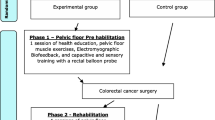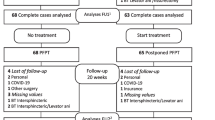Abstract
Introduction and hypothesis
The objective of this study is to determine the effect of posterior colporrhaphy on bowel symptoms.
Methods
Comprehensive pelvic floor data were collected prospectively for 60 women undergoing posterior colporrhaphy. The electronic Personal Assessment Questionnaire-Pelvic Floor (ePAQ-PF) was completed at initial assessment and 3–6 months post-operatively. The bowel dimension of ePAQ-PF computes domain scores for IBS, constipation, evacuation, continence and QoL on a scale of 0–100. Preoperative bowel domain scores were compared with post-operative scores (Student t test).
Results
Significant improvement was seen in bowel evacuation (42%), continence (37%) and bowel-related QoL (61%) scores. IBS score improved by 28%, but this did not reach significance. There was no significant change noted in constipation (0.5%). All individual symptoms relating to bowel evacuation and continence improved significantly other than painful evacuation and incontinence to solid stool.
Conclusions
Bowel evacuation and continence improve significantly 3–6 months following posterior colporrhaphy and are associated with parallel improvement in QoL.
Similar content being viewed by others
References
Olsen AL, Smith VJ, Bergstorm JO, Colling JC, Clark AL (1997) Epidemiology of surgically managed pelvic organ prolapse and urinary incontinence. Obstet Gynecol 89(4):501–506
Mollen RHMG, van Larrhoven CJHM, Kuijpers JHC (1996) Pathogenesis and management of rectocoeles. Semin Colorectal Surg 7:192–196
Dietz HP, Korda A (2005) Which bowel symptoms are most strongly associated with true rectocoele? Aust N Z J Obstet Gynaecol 45(6):505–508
Da Silva GM, Gurland B, Sleemi A, Levy G (2006) Posterior vaginal wall prolapse does not correlate with fecal symptoms or objective measures of anorectal function. Am J Obstet Gynecol 195(6):1742–1747
Weber AM, Walters MD, Ballard LA, Booher DL, Peidmonte MR (1998) Posterior vaginal wall prolapse and sexual function. Am J Obstet Gynecol 179(6):14446–14450
Ellerkman MR, Cundiff GW, Melick CF, Nihira MA, Leffler K, Bent AE (2001) Correlation of symptoms with location and severity of pelvic organ prolapse. Am J Obstet Gynecol 185:1332–1338
Kahn MA, Stanton SL (1997) Posterior colporrhaphy: its effect on bowel and sexual function. Br J Obstet Gynaecol 104:82–86
Sloots CEJ, Muelen AJ, Felt-Bersma RJ (2003) Rectocoele repair improves evacuation and prolapse complaints independent of anorectal function and colonic transit time. Int J Colorectal Dis 18:342–348
Maher CF, Qatawneh AM, Baessler K, Schluter PJ (2004) Midline rectovaginal fascial plication for repair of rectocoele and obstructive defecation. Obstet Gynecol 104(4):685–689
Maher C, Feiner B, Baessler K, Glazener CMA (2010) Surgical management of pelvic organ prolapse in women. Cochrane Database of Systematic Reviews 2010, Issue 4. Art. No.: CD004014. doi:10.1002/14651858.CD004014.pub4
Cundiff GW, Fenner D (2004) Evaluation and treatment of women with rectocoele: focus on associated defecatory and sexual dysfunction. Obstet Gynecol 104(6):1403–1421
Radley SC, Jones GL, Ea T, Stevens VG, Nelson C, Mathers NJ (2006) Computer interviewing in urogynaecology, concept, development and psychometric testing of an electronic pelvic floor assessment questionnaire in primary and secondary care. BJOG 113:231–238
Jones GL, Radley SC, Lumb J, Farkas A (2009) Responsiveness of the electronic Personal Assessment Questionnaire—Pelvic Floor (ePAQ-PF). Int Urogynecol J Pelvic Floor Dysfunct 20:557–564
Woodend AK, Nair RC, Tang AS (1997) Definition of life quality from a patient versus health care professional perspective. Int J Rehabil Res 20:71–80
Korman HJ, Sirls LT, Kirkemo AK (1994) Success rate of modified Pereyra bladder neck suspension determined by outcomes analysis. J Urol 152:1453–1457
Gustilo-Ashby AM, Paraiso MF, Jelovsek JE, Walters MD, Barber MD (2007) Bowel symptoms 1 year after surgery for prolapse: further analysis of a randomized trial of rectocele repair. Am J Obstet Gynecol 197:76.e1–76.e5
Burrows LJ, Meyn LA, Walters MD, Weber AM (2004) Pelvic symptoms in women with pelvic organ prolapse. Obstet Gynecol 104(5):982–988
Paraiso MF, Barber MD, Muir TW, Walters MD (2006) Rectocele repair: a randomized trial of three surgical techniques including graft augmentation. Am J Obstet Gynecol 195(6):1762–1771
Engel AF, Kamm MA, Bartram CI, Nicholls RJ (1995) Relationship of symptoms in faecal incontinence to specific sphincter abnormalities. Int J Colorectal Dis 10:152–155
Lennard-Jones JE (1993) Clinical management of constipation. Phamacology 47:216–223
Conflicts of interest
Stephen Radley is a shareholder in ePAQ Systems Ltd., an NHS spin-out technology company.
Author information
Authors and Affiliations
Corresponding author
Rights and permissions
About this article
Cite this article
Dua, A., Radley, S., Brown, S. et al. The effect of posterior colporrhaphy on anorectal function. Int Urogynecol J 23, 749–753 (2012). https://doi.org/10.1007/s00192-011-1603-0
Received:
Accepted:
Published:
Issue Date:
DOI: https://doi.org/10.1007/s00192-011-1603-0




